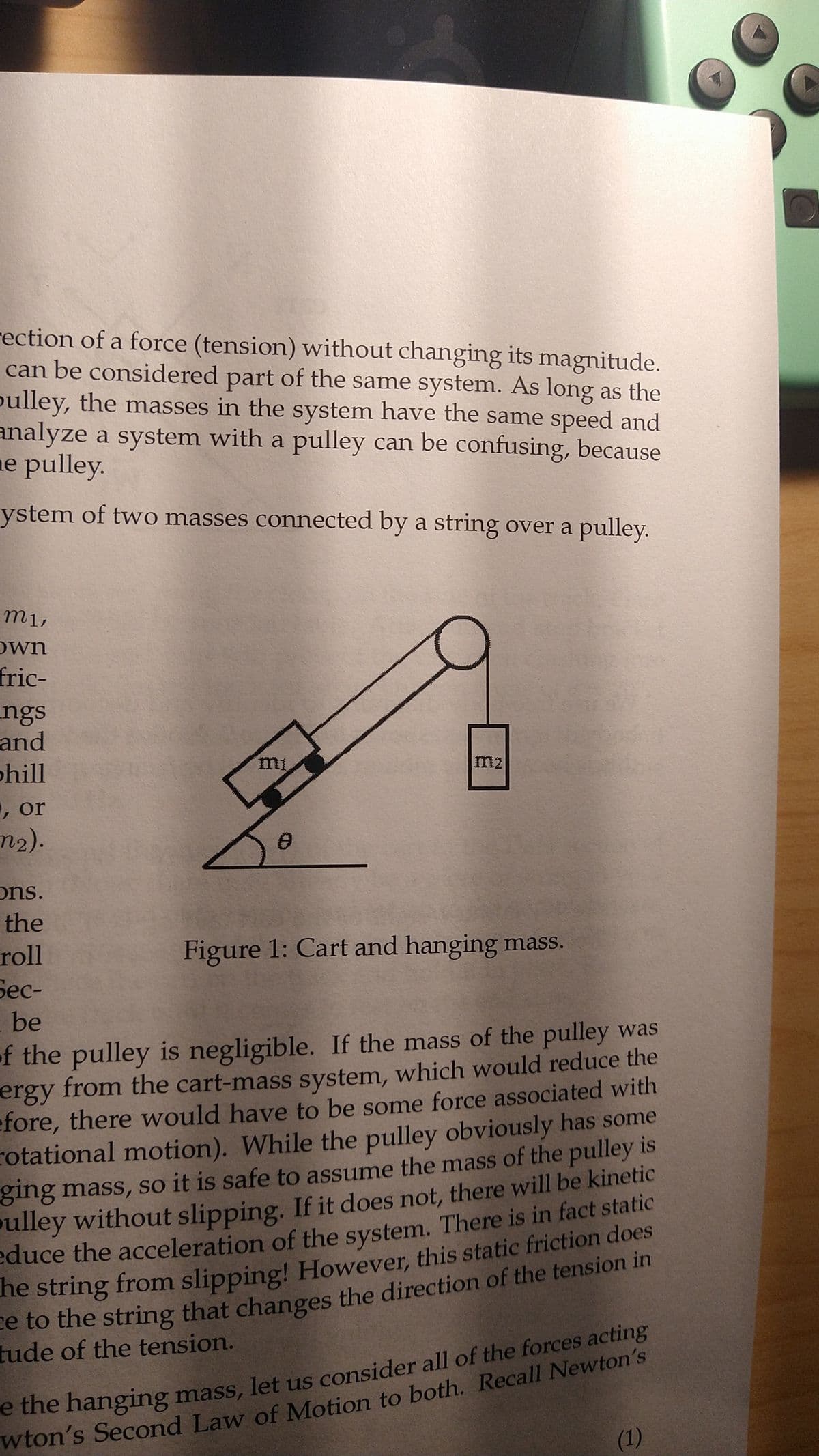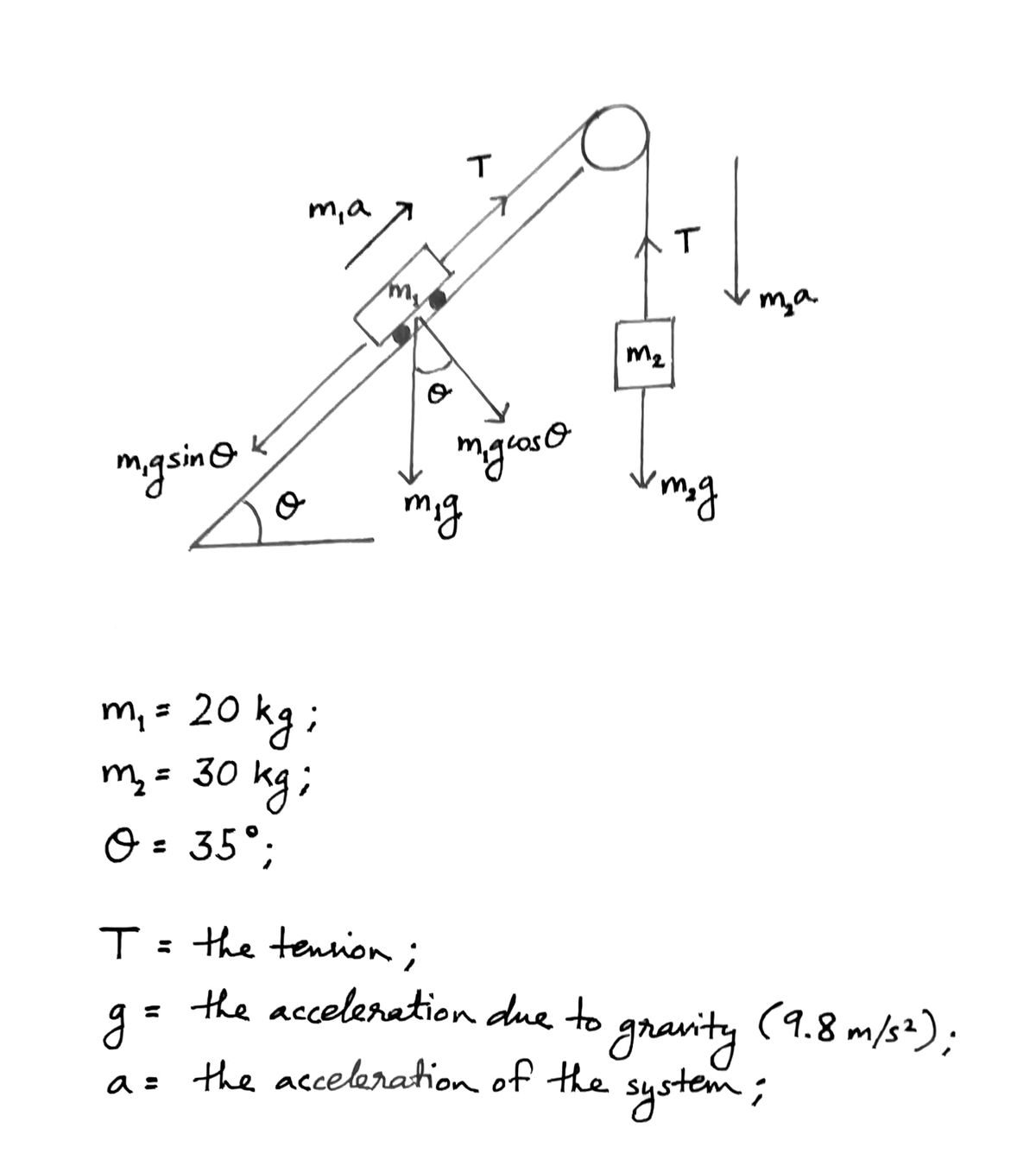assume that you are studying a cart and mass system. given m1 = 20kg and m2 = 30 kg and theta = 35 degrees, find the acceleration, a, and the tension, T, of the system.
assume that you are studying a cart and mass system. given m1 = 20kg and m2 = 30 kg and theta = 35 degrees, find the acceleration, a, and the tension, T, of the system.
College Physics
1st Edition
ISBN:9781938168000
Author:Paul Peter Urone, Roger Hinrichs
Publisher:Paul Peter Urone, Roger Hinrichs
Chapter4: Dynamics: Force And Newton's Laws Of Motion
Section: Chapter Questions
Problem 22CQ: Ina traction setup a broken bone, with pulleys and rope available, how might we be able to Increase...
Related questions
Question
assume that you are studying a cart and mass system. given m1 = 20kg and m2 = 30 kg and theta = 35 degrees, find the acceleration, a, and the tension, T, of the system.

Transcribed Image Text:rection of a force (tension) without changing its magnitude.
can be considered part of the same system. As long as the
pulley, the masses in the system have the same speed and
analyze a system with a pulley can be confusing, because
e pulley.
ystem of two masses connected by a string over a pulley.
m1,
own
fric-
ngs
and
phill
, or
m₂).
mi
ons.
the
roll
Sec-
be
of the pulley is negligible. If the mass of the pulley was
ergy from the cart-mass system, which would reduce the
efore, there would have to be some force associated with
rotational motion). While the pulley obviously has some
ging mass, so it is safe to assume the mass of the pulley is
pulley without slipping. If it does not, there will be kinetic
educe the acceleration of the system. There is in fact static
he string from slipping! However, this static friction does
ce to the string that changes the direction of the tension in
tude of the tension.
Figure 1: Cart and hanging mass.
e the hanging mass, let us consider all of the forces acting
wton's Second Law of Motion to both. Recall Newton's
(1)
Expert Solution
Free Body Diagram

Trending now
This is a popular solution!
Step by step
Solved in 2 steps with 3 images

Knowledge Booster
Learn more about
Need a deep-dive on the concept behind this application? Look no further. Learn more about this topic, physics and related others by exploring similar questions and additional content below.Recommended textbooks for you

College Physics
Physics
ISBN:
9781938168000
Author:
Paul Peter Urone, Roger Hinrichs
Publisher:
OpenStax College

University Physics Volume 1
Physics
ISBN:
9781938168277
Author:
William Moebs, Samuel J. Ling, Jeff Sanny
Publisher:
OpenStax - Rice University

Principles of Physics: A Calculus-Based Text
Physics
ISBN:
9781133104261
Author:
Raymond A. Serway, John W. Jewett
Publisher:
Cengage Learning

College Physics
Physics
ISBN:
9781938168000
Author:
Paul Peter Urone, Roger Hinrichs
Publisher:
OpenStax College

University Physics Volume 1
Physics
ISBN:
9781938168277
Author:
William Moebs, Samuel J. Ling, Jeff Sanny
Publisher:
OpenStax - Rice University

Principles of Physics: A Calculus-Based Text
Physics
ISBN:
9781133104261
Author:
Raymond A. Serway, John W. Jewett
Publisher:
Cengage Learning

Physics for Scientists and Engineers
Physics
ISBN:
9781337553278
Author:
Raymond A. Serway, John W. Jewett
Publisher:
Cengage Learning

Physics for Scientists and Engineers with Modern …
Physics
ISBN:
9781337553292
Author:
Raymond A. Serway, John W. Jewett
Publisher:
Cengage Learning

Physics for Scientists and Engineers, Technology …
Physics
ISBN:
9781305116399
Author:
Raymond A. Serway, John W. Jewett
Publisher:
Cengage Learning